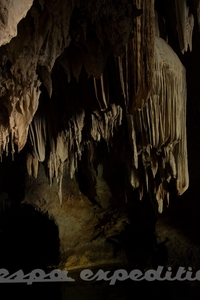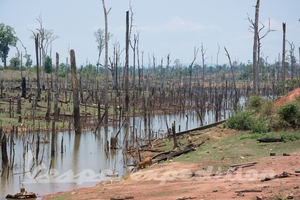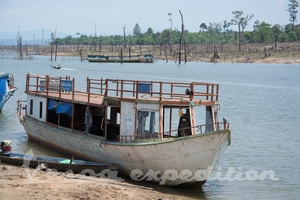Laos has a very special culture. As the name Lao People's Democratic Republic suggests it is Communist country. All over the country you will find flags with sickle and hammer on them which of course is nothing special. But what really surprised us is the mixture of communism and religion. When we first encountered a sanctuary that looked similar to the Thai altar, but instead of Buddha it had the bust of Kayson Phomviane (one of the leaders of the revolution), it made us laugh. We were really surprised when we realized that they really mean it. Here, in some way, they eradicated the idea that faith is opium of humanity. Supposedly the supreme himself (again Kayson) was a great Buddhist himself.
I've visited the Revolutionary Cemetery near Vientiane and here are graves of Communist elite, on which there is protective goddess Apsara on one side and on the other is sickle and hammer. I have not seen such a mix anywhere else.
At the same time, they have for us a bit incomprehensible style of building ornamental parks dedicated to these symbols. The village on the Bolavean Plateau, which has around 1,000 inhabitants and is set in the middle of greenery, has one park with statues of revolutionaries, and two more are being built on its edges. I think that there is not a city which have much man-made greenery per capita. Either the Laotian are megalomaniacs, or the visionaries, the decision is left to up you.
In Laos, LPG stations vanished. We knew that it will happen eventually. Our toucan had to switch to the classic cooking gas in bottles. Prices in Laos have surprised us quite a bit. From common 50 cents / kg, the price raised to 1,75 USD / kg, which is high enough. In order not run out of fuel, we have to carry two bottles.
So when we finally found our first LPG station in Thakhek, we immediately got our tank full to the max. We didn't know yet that there is still more to fill. The guys are enterprising and because the filling hose has the same nozzle as the gas bomb, they offer us its refuel. The price is one third lower and so we agree avidly. There is still around 5 kg of gas remaining in one bottle. It's normal capacity is 15 kg. The guy keys something in on the pump and is already filling the bottle. Before you say "propane-butane" another 22 kg of gas is already in our bottle. It is crammed with 27 kgs and it looks like it is rounding. The guy runs over to the second bottle, which is empty too. No way!! We are leaving and behind first corner we pour the gas from the melon-shaped bottle into the empty one. As the pressure in the bottle decreases, our clamped butt cheeks are also getting relaxed. Next time we'd rather look carefully over the the filling, otherwise in the end we'll have the cheeks made of iron.
One part of Laos boasts beautiful limestone hills full of karst caves. Of course that we can not miss this. We're heading to the Buddha Cave. Several years ago a bats hunter climbed up there and discovered hundreds of statues about 300 years old. They were probably hidden here from the raids of Thais. Around the cave there are not too many signs, and so we find a incidentally a sign to another cave nearby. We have time and so it's not a problem. If it wasn't for a bunch of locals we would never find it, which wold be a pity. The cave with lake is full of stalactites and stalagmites, and there is nobody here at all. Something like that would have it's own admission and hundreds of visitors in our home. We go on along the path and it leads us to the rock wall where it ends. Suddenly, we notice the slightly worn stones, and they lead us into a cave that leads to the other side of the cliff. When we finally get to the Buddha cave, we will do not find suddenly it so interesting. Concrete stairs lead to it, and there are several locals overseeing the abiding of rules.
































